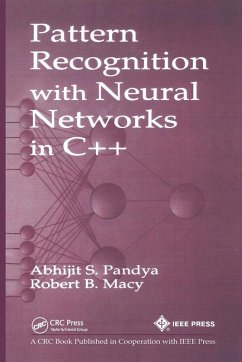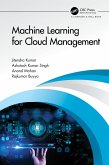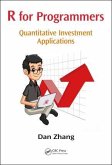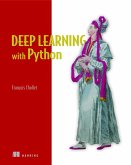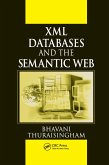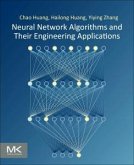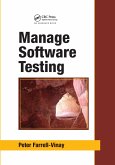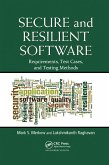- Broschiertes Buch
- Merkliste
- Auf die Merkliste
- Bewerten Bewerten
- Teilen
- Produkt teilen
- Produkterinnerung
- Produkterinnerung
The addition of artificial neural network computing to traditional pattern recognition has given rise to a new, different, and more powerful methodology that is presented in this interesting book. This is a practical guide to the application of artificial neural networks.
Andere Kunden interessierten sich auch für
![Machine Learning for Cloud Management Machine Learning for Cloud Management]() Jitendra KumarMachine Learning for Cloud Management82,99 €
Jitendra KumarMachine Learning for Cloud Management82,99 €![R for Programmers R for Programmers]() Dan ZhangR for Programmers100,99 €
Dan ZhangR for Programmers100,99 €![Deep Learning with Python Deep Learning with Python]() Francois CholletDeep Learning with Python54,99 €
Francois CholletDeep Learning with Python54,99 €![XML Databases and the Semantic Web XML Databases and the Semantic Web]() Bhavani ThuraisinghamXML Databases and the Semantic Web85,99 €
Bhavani ThuraisinghamXML Databases and the Semantic Web85,99 €![Neural Network Algorithms and Their Engineering Applications Neural Network Algorithms and Their Engineering Applications]() Chao HuangNeural Network Algorithms and Their Engineering Applications188,99 €
Chao HuangNeural Network Algorithms and Their Engineering Applications188,99 €![Manage Software Testing Manage Software Testing]() Peter Farrell-VinayManage Software Testing82,99 €
Peter Farrell-VinayManage Software Testing82,99 €![Secure and Resilient Software Secure and Resilient Software]() Mark S MerkowSecure and Resilient Software82,99 €
Mark S MerkowSecure and Resilient Software82,99 €-
-
-
The addition of artificial neural network computing to traditional pattern recognition has given rise to a new, different, and more powerful methodology that is presented in this interesting book. This is a practical guide to the application of artificial neural networks.
Hinweis: Dieser Artikel kann nur an eine deutsche Lieferadresse ausgeliefert werden.
Hinweis: Dieser Artikel kann nur an eine deutsche Lieferadresse ausgeliefert werden.
Produktdetails
- Produktdetails
- Verlag: CRC Press
- Seitenzahl: 426
- Erscheinungstermin: 17. Dezember 2019
- Englisch
- Abmessung: 234mm x 156mm x 22mm
- Gewicht: 594g
- ISBN-13: 9780367448875
- ISBN-10: 0367448874
- Artikelnr.: 58502408
- Herstellerkennzeichnung
- Libri GmbH
- Europaallee 1
- 36244 Bad Hersfeld
- gpsr@libri.de
- Verlag: CRC Press
- Seitenzahl: 426
- Erscheinungstermin: 17. Dezember 2019
- Englisch
- Abmessung: 234mm x 156mm x 22mm
- Gewicht: 594g
- ISBN-13: 9780367448875
- ISBN-10: 0367448874
- Artikelnr.: 58502408
- Herstellerkennzeichnung
- Libri GmbH
- Europaallee 1
- 36244 Bad Hersfeld
- gpsr@libri.de
Pandya, Abhijit S.; Macy, Robert B.
Introduction Pattern Recognition Systems Motivation for Artificial Neural
Network Approach A Prelude to Pattern Recognition Statistical Pattern
Recognition Syntactic Pattern Recognition The Character Recognition Problem
Organization of Topics Neural Networks: An Overview Motivation for
Overviewing Biological Neural Networks Background Biological Neural
Networks Hierarchical Organization of the Brain Historical Background
Artificial Neural Networks Preprocessing General Dealing with Input from a
Scanned Image Image Compression Edge Detection Skeletonizing Dealing with
Input from a Tablet Segmentation Feed Forward Networks with Supervised
Learning Feed-Forward Multilayer Perceptron (FFMLP) Architecture FFMLP in
C++ Training with Back Propagation A Primitive Example Training Strategies
and Avoiding Local Minima Variations on Gradient Descent Topology ACON vs.
OCON Overtraining and Generalization Training Set Size and Network Size
Conjugate Gradient Method ALOPEX Some Other Types of Neural Networks
General Radial Basis Function Networks Higher Order Neural Networks Feature
Extraction I: Geometric Features and Transformations General Geometric
Features (Loops, Intersections and Endpoints) Feature Maps A Network
Example Using Geometric Features Feature Extraction Using Transformations
Fourier Descriptors Gabor Transformations and Wavelets Feature Extraction
II: Principle Component Analysis Dimensionality Reduction Principal
Components Karhunen-Loeve (K-L) Transformation Principal Component Neural
Networks Applications Kohonen Networks and Learning Vector Quantization
General K-Means Algorithm An Introduction to the Kohonen Model The Role of
Lateral Feedback Kohonen Self-Organizing Feature Map Learning Vector
Quantization Variations on LVQ Neural Associative Memories and Hopfield
Networks General Linear Associative Memory (LAM) Hopfield Networks A
Hopfield Example Discussion Bit Map Example BAM Networks A BAM Example
Adaptive Resonance Theory (ART) General Discovering the Cluster Structure
Vector Quantization ART Philosophy The Stability-Plasticity Dilemma Art1:
Basic Operation Art1: Algorithm The Gain Control Mechanism ART2 Model
Discussion Applications Neocognition Introduction Architecture Example of a
System with Sample Training Patterns Systems with Multiple Classifiers
General A Framework for Combining Multiple Recognizers Voting Schemes The
Confusion Matrix Reliability Some Empirical Approaches
Network Approach A Prelude to Pattern Recognition Statistical Pattern
Recognition Syntactic Pattern Recognition The Character Recognition Problem
Organization of Topics Neural Networks: An Overview Motivation for
Overviewing Biological Neural Networks Background Biological Neural
Networks Hierarchical Organization of the Brain Historical Background
Artificial Neural Networks Preprocessing General Dealing with Input from a
Scanned Image Image Compression Edge Detection Skeletonizing Dealing with
Input from a Tablet Segmentation Feed Forward Networks with Supervised
Learning Feed-Forward Multilayer Perceptron (FFMLP) Architecture FFMLP in
C++ Training with Back Propagation A Primitive Example Training Strategies
and Avoiding Local Minima Variations on Gradient Descent Topology ACON vs.
OCON Overtraining and Generalization Training Set Size and Network Size
Conjugate Gradient Method ALOPEX Some Other Types of Neural Networks
General Radial Basis Function Networks Higher Order Neural Networks Feature
Extraction I: Geometric Features and Transformations General Geometric
Features (Loops, Intersections and Endpoints) Feature Maps A Network
Example Using Geometric Features Feature Extraction Using Transformations
Fourier Descriptors Gabor Transformations and Wavelets Feature Extraction
II: Principle Component Analysis Dimensionality Reduction Principal
Components Karhunen-Loeve (K-L) Transformation Principal Component Neural
Networks Applications Kohonen Networks and Learning Vector Quantization
General K-Means Algorithm An Introduction to the Kohonen Model The Role of
Lateral Feedback Kohonen Self-Organizing Feature Map Learning Vector
Quantization Variations on LVQ Neural Associative Memories and Hopfield
Networks General Linear Associative Memory (LAM) Hopfield Networks A
Hopfield Example Discussion Bit Map Example BAM Networks A BAM Example
Adaptive Resonance Theory (ART) General Discovering the Cluster Structure
Vector Quantization ART Philosophy The Stability-Plasticity Dilemma Art1:
Basic Operation Art1: Algorithm The Gain Control Mechanism ART2 Model
Discussion Applications Neocognition Introduction Architecture Example of a
System with Sample Training Patterns Systems with Multiple Classifiers
General A Framework for Combining Multiple Recognizers Voting Schemes The
Confusion Matrix Reliability Some Empirical Approaches
Introduction Pattern Recognition Systems Motivation for Artificial Neural
Network Approach A Prelude to Pattern Recognition Statistical Pattern
Recognition Syntactic Pattern Recognition The Character Recognition Problem
Organization of Topics Neural Networks: An Overview Motivation for
Overviewing Biological Neural Networks Background Biological Neural
Networks Hierarchical Organization of the Brain Historical Background
Artificial Neural Networks Preprocessing General Dealing with Input from a
Scanned Image Image Compression Edge Detection Skeletonizing Dealing with
Input from a Tablet Segmentation Feed Forward Networks with Supervised
Learning Feed-Forward Multilayer Perceptron (FFMLP) Architecture FFMLP in
C++ Training with Back Propagation A Primitive Example Training Strategies
and Avoiding Local Minima Variations on Gradient Descent Topology ACON vs.
OCON Overtraining and Generalization Training Set Size and Network Size
Conjugate Gradient Method ALOPEX Some Other Types of Neural Networks
General Radial Basis Function Networks Higher Order Neural Networks Feature
Extraction I: Geometric Features and Transformations General Geometric
Features (Loops, Intersections and Endpoints) Feature Maps A Network
Example Using Geometric Features Feature Extraction Using Transformations
Fourier Descriptors Gabor Transformations and Wavelets Feature Extraction
II: Principle Component Analysis Dimensionality Reduction Principal
Components Karhunen-Loeve (K-L) Transformation Principal Component Neural
Networks Applications Kohonen Networks and Learning Vector Quantization
General K-Means Algorithm An Introduction to the Kohonen Model The Role of
Lateral Feedback Kohonen Self-Organizing Feature Map Learning Vector
Quantization Variations on LVQ Neural Associative Memories and Hopfield
Networks General Linear Associative Memory (LAM) Hopfield Networks A
Hopfield Example Discussion Bit Map Example BAM Networks A BAM Example
Adaptive Resonance Theory (ART) General Discovering the Cluster Structure
Vector Quantization ART Philosophy The Stability-Plasticity Dilemma Art1:
Basic Operation Art1: Algorithm The Gain Control Mechanism ART2 Model
Discussion Applications Neocognition Introduction Architecture Example of a
System with Sample Training Patterns Systems with Multiple Classifiers
General A Framework for Combining Multiple Recognizers Voting Schemes The
Confusion Matrix Reliability Some Empirical Approaches
Network Approach A Prelude to Pattern Recognition Statistical Pattern
Recognition Syntactic Pattern Recognition The Character Recognition Problem
Organization of Topics Neural Networks: An Overview Motivation for
Overviewing Biological Neural Networks Background Biological Neural
Networks Hierarchical Organization of the Brain Historical Background
Artificial Neural Networks Preprocessing General Dealing with Input from a
Scanned Image Image Compression Edge Detection Skeletonizing Dealing with
Input from a Tablet Segmentation Feed Forward Networks with Supervised
Learning Feed-Forward Multilayer Perceptron (FFMLP) Architecture FFMLP in
C++ Training with Back Propagation A Primitive Example Training Strategies
and Avoiding Local Minima Variations on Gradient Descent Topology ACON vs.
OCON Overtraining and Generalization Training Set Size and Network Size
Conjugate Gradient Method ALOPEX Some Other Types of Neural Networks
General Radial Basis Function Networks Higher Order Neural Networks Feature
Extraction I: Geometric Features and Transformations General Geometric
Features (Loops, Intersections and Endpoints) Feature Maps A Network
Example Using Geometric Features Feature Extraction Using Transformations
Fourier Descriptors Gabor Transformations and Wavelets Feature Extraction
II: Principle Component Analysis Dimensionality Reduction Principal
Components Karhunen-Loeve (K-L) Transformation Principal Component Neural
Networks Applications Kohonen Networks and Learning Vector Quantization
General K-Means Algorithm An Introduction to the Kohonen Model The Role of
Lateral Feedback Kohonen Self-Organizing Feature Map Learning Vector
Quantization Variations on LVQ Neural Associative Memories and Hopfield
Networks General Linear Associative Memory (LAM) Hopfield Networks A
Hopfield Example Discussion Bit Map Example BAM Networks A BAM Example
Adaptive Resonance Theory (ART) General Discovering the Cluster Structure
Vector Quantization ART Philosophy The Stability-Plasticity Dilemma Art1:
Basic Operation Art1: Algorithm The Gain Control Mechanism ART2 Model
Discussion Applications Neocognition Introduction Architecture Example of a
System with Sample Training Patterns Systems with Multiple Classifiers
General A Framework for Combining Multiple Recognizers Voting Schemes The
Confusion Matrix Reliability Some Empirical Approaches

